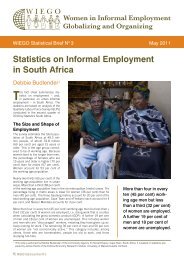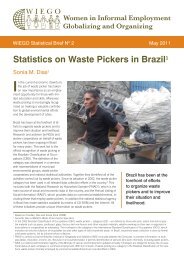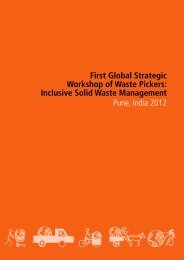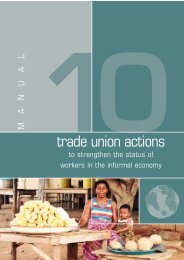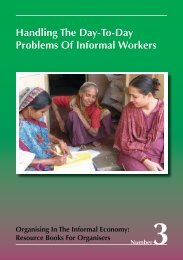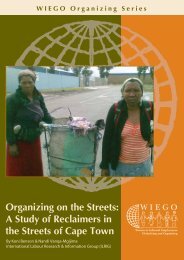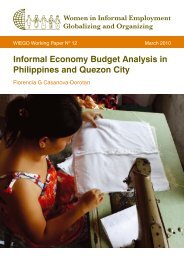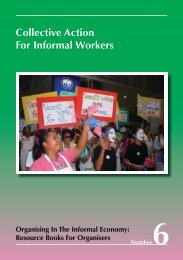Options for Organizing Waste Pickers in South Africa - WIEGO
Options for Organizing Waste Pickers in South Africa - WIEGO
Options for Organizing Waste Pickers in South Africa - WIEGO
You also want an ePaper? Increase the reach of your titles
YUMPU automatically turns print PDFs into web optimized ePapers that Google loves.
<strong>WIEGO</strong> <strong>Organiz<strong>in</strong>g</strong> Brief No. 3<strong>Options</strong><strong>for</strong><strong>Organiz<strong>in</strong>g</strong><strong>Waste</strong><strong>Pickers</strong> <strong>in</strong><strong>South</strong><strong>Africa</strong> By Jan Theron
<strong>Options</strong> <strong>for</strong> <strong>Organiz<strong>in</strong>g</strong> <strong>Waste</strong> <strong>Pickers</strong> <strong>in</strong> <strong>South</strong> <strong>Africa</strong>ContentsSection 1: Introduction.................................................................................................................................. 1Purpose................................................................................................................................................. 1Outl<strong>in</strong>e.................................................................................................................................................. 1Case Study: <strong>Waste</strong> Management <strong>in</strong> Sasolburg...................................................................................... 2What Can We Learn from This Case Study?................................................................................... 3Section 2: Employment Versus Self-Employment;Work<strong>in</strong>g on Your Own Versus Work<strong>in</strong>g Collectively............................................................................. 5What Does It Mean to Be “Employed”?.......................................................................................... 5The Difference Between the “Formal” and “In<strong>for</strong>mal Economy”?.............................................. 6What Does It Mean to Be Self-Employed?....................................................................................... 7Benefits and Risks of Individual Self-Employment....................................................................... 7Benefits and Risks of Becom<strong>in</strong>g an Employer................................................................................ 8Benefits and Risks of Work<strong>in</strong>g Collectively.................................................................................... 8What Is a “Surplus”?............................................................................................................................ 9Section 3: What to Consider when Form<strong>in</strong>g an Organization............................................................. 11What Is the Objective of the Organization or Group?................................................................. 11Pr<strong>in</strong>ciples............................................................................................................................................ 11Develop<strong>in</strong>g a Plan <strong>for</strong> the Organization........................................................................................ 12SWOT Analysis................................................................................................................................... 12The Struggle <strong>for</strong> Recognition........................................................................................................... 13Section 4: What Different K<strong>in</strong>ds of Organizations or Groups May Be Formed?............................ 14Does Your Organization or Group Need to Be Registered?........................................................ 14Associations....................................................................................................................................... 15Associations Operat<strong>in</strong>g as a Bus<strong>in</strong>ess................................................................................ 15Trade Unions and Unions.................................................................................................... 16Bus<strong>in</strong>ess Groups................................................................................................................................ 16Partnership............................................................................................................................. 16Close Corporations............................................................................................................... 17Companies............................................................................................................................. 17Cooperatives.......................................................................................................................... 18Cooperative Pr<strong>in</strong>ciples ........................................................................................................................ 19Where Do You Go <strong>for</strong> Help?............................................................................................................ 21Conclusions ................................................................................................................................................. 23Appendix ................................................................................................................................................. 23i
<strong>WIEGO</strong> <strong>Organiz<strong>in</strong>g</strong> Brief No. 3ii
<strong>Options</strong> <strong>for</strong> <strong>Organiz<strong>in</strong>g</strong> <strong>Waste</strong> <strong>Pickers</strong> <strong>in</strong> <strong>South</strong> <strong>Africa</strong>Section 1: IntroductionThis booklet is <strong>for</strong> waste pickers <strong>in</strong> <strong>South</strong> <strong>Africa</strong>. <strong>Waste</strong> pickers (who are also known asreclaimers) are workers engaged <strong>in</strong> collect<strong>in</strong>g recyclable materials gathered from refuse, landfillsites and elsewhere, which they sell <strong>for</strong> a liv<strong>in</strong>g.Although there are some waste pickers who work <strong>for</strong> someone else, most waste pickers havecreated their own jobs, and work <strong>for</strong> themselves: <strong>in</strong> other words they are self-employed.One of the reasons workers have created their own jobs is because there are so few jobopportunities <strong>in</strong> what we shall call the “<strong>for</strong>mal economy” nowadays. This does not mean the workwaste pickers do is unimportant. In fact the work waste pickers do is very important, and it is notsufficiently recognized.PurposeIf waste pickers were organized, they would be better able to w<strong>in</strong> recognition <strong>for</strong> the work theydo. The ma<strong>in</strong> purpose of this booklet is to help waste pickers organize themselves, by expla<strong>in</strong><strong>in</strong>gthe different options <strong>for</strong> workers <strong>in</strong> their situation.Although directed at waste pickers, the arguments advanced <strong>in</strong> this booklet should also apply toother self-employed workers who want to organize themselves.Outl<strong>in</strong>eTo decide what <strong>for</strong>m of organization is best <strong>for</strong> them, it is important to understand the differencebetween employment and self-employment.A big difference between employed workers and self-employed workers is that there arenumerous laws that protect workers who are employed, whereas there are few protections <strong>for</strong>self-employed workers.In the next section of the booklet, section 2, we expla<strong>in</strong> <strong>in</strong> more detail about the laws that applyto employed workers, and the dist<strong>in</strong>ction between employment and self-employment, as wellas between the “<strong>for</strong>mal” and “<strong>in</strong><strong>for</strong>mal economy”. We go on to consider the different waysself-employed workers could operate: as <strong>in</strong>dividuals work<strong>in</strong>g on their own, as an employer, orwork<strong>in</strong>g collectively as part of an organization or group.In section 3 we consider how workers go about <strong>for</strong>m<strong>in</strong>g an organization or group, dist<strong>in</strong>guish<strong>in</strong>gbetween different stages: decid<strong>in</strong>g what the organization’s objective is, determ<strong>in</strong><strong>in</strong>g the k<strong>in</strong>d ofprovisions it would need to have <strong>in</strong> a constitution or equivalent document, and develop<strong>in</strong>g awell-thought out strategy or plan as to how the workers will work together as an organization.Whatever organization waste pickers <strong>for</strong>m, we suggest it will have to be prepared to struggle <strong>for</strong>recognition. We detail <strong>in</strong> this section what recognition might entail.In section 4 we discuss <strong>in</strong> more detail the different k<strong>in</strong>ds of groups or organizations that may be<strong>for</strong>med, and the advantages as well as disadvantages of each.On the follow<strong>in</strong>g page we give a case study of waste pickers that we will draw from to illustratethe challenges waste pickers face <strong>in</strong> organiz<strong>in</strong>g themselves.1
<strong>WIEGO</strong> <strong>Organiz<strong>in</strong>g</strong> Brief No. 34
<strong>Options</strong> <strong>for</strong> <strong>Organiz<strong>in</strong>g</strong> <strong>Waste</strong> <strong>Pickers</strong> <strong>in</strong> <strong>South</strong> <strong>Africa</strong>economy. Because of people such as these, it is argued that the self-employed are <strong>in</strong>dependent andable to provide <strong>for</strong> their own social protection. It is there<strong>for</strong>e argued there is no need to extend tothe self-employed the k<strong>in</strong>d of protections that apply to employed workers.What Does It Mean to Be Self-Employed?It is of course untrue that most self-employed persons are <strong>in</strong>dependent and able to provide <strong>for</strong>their own social protection. <strong>Waste</strong> pickers, <strong>for</strong> example, are <strong>in</strong>dependent <strong>in</strong>sofar as they controltheir own work<strong>in</strong>g hours and decide <strong>for</strong> themselves what to collect. But they are not truly<strong>in</strong>dependent.First and <strong>for</strong>emost waste pickers are dependent on the local authority as well as other divisions ofgovernment who can facilitate their work <strong>in</strong> ways we will discuss below, or restrict them. In thecase of Sasolburg, as we have seen, local government has restricted the operation of waste pickers.<strong>Waste</strong> pickers are also dependent on be<strong>in</strong>g able to sell what they collect to middlemen and others,who pay them accord<strong>in</strong>g to the volume of material delivered. One of the objects of organiz<strong>in</strong>gwaste pickers would be to lessen this dependence.Legally, the difference between employment and self-employment is that the self-employed do nothave a contract of employment. Labour legislation only applies to workers who have a contract ofemployment, although this does not have to be <strong>in</strong> writ<strong>in</strong>g.Although the self-employed worker does not have a contract of employment, the worker mayhave another k<strong>in</strong>d of contract with the person they work <strong>for</strong>. This k<strong>in</strong>d of contract is called acommercial contract, and the worker is normally referred to as an “<strong>in</strong>dependent contractor” <strong>in</strong>such contracts.The ma<strong>in</strong> difference between a commercial contract and an employment contract is that theworker is usually paid a lump sum or fee <strong>for</strong> complet<strong>in</strong>g the task, and it is left up to the workerhow he or she does so. Commercial contracts are also easy to term<strong>in</strong>ate.It is the person to whom workers are contracted who will usually term<strong>in</strong>ate the contract,sometimes because they can get someone else to work <strong>for</strong> them <strong>for</strong> less. This means such workersdo not have job security.Workers are also at a disadvantage <strong>in</strong> enter<strong>in</strong>g such contracts because they are generally not ableto have access to a lawyer <strong>in</strong> the draw<strong>in</strong>g up of such a contract. Such contracts are also difficult toen<strong>for</strong>ce without access to a lawyer.Sometimes people who are really employers enter <strong>in</strong>to commercial contracts with workersbecause they want to disguise the true nature of their relationship with the workers, or becausethey consider commercial contracts advantageous. The Labour Relations Act provides a procedurewhereby workers <strong>in</strong> this situation can be declared employees 4 .Benefits and Risks of Individual Self-EmploymentThe benefit of work<strong>in</strong>g on your own is that you are your own boss, and able to take fullresponsibility <strong>for</strong> the work you do. You also do not have to accept responsibility <strong>for</strong> the fail<strong>in</strong>gs ofothers, and there is no issue of shar<strong>in</strong>g <strong>in</strong>come with others.The risk of work<strong>in</strong>g on your own is that you are more vulnerable than you would be if you werepart of a group. The case study of the Sasolburg waste pickers illustrates this. As <strong>in</strong>dividuals,waste pickers are far more vulnerable to competitors: <strong>in</strong> fact every other waste picker may be acompetitor.4Section 200A, LRA, No 66 of 1995.7
<strong>WIEGO</strong> <strong>Organiz<strong>in</strong>g</strong> Brief No. 3As an <strong>in</strong>dividual you are also more vulnerable <strong>in</strong> the event of ill-health or <strong>in</strong>jury or a temporarydrop <strong>in</strong> <strong>in</strong>come. A group may not be able to prevent these th<strong>in</strong>gs happen<strong>in</strong>g, but collectively thegroup can take steps to limit the impact on the <strong>in</strong>dividual worker.There are also limits to how much a self-employed <strong>in</strong>dividual can do on her or his own i.e. thereis a problem of capacity. If, there<strong>for</strong>e, an <strong>in</strong>dividual is successful, she or he will need to overcomeproblems of capacity. One way of do<strong>in</strong>g so is to employ someone to assist her or him. Anotherway is to l<strong>in</strong>k up with others, and operate collectively.There are two other disadvantages of operat<strong>in</strong>g as an <strong>in</strong>dividual that highlight the importance o<strong>for</strong>ganization:• It is unrealistic <strong>for</strong> waste pickers to negotiate as <strong>in</strong>dividuals. It will not be possible toimprove the situation of waste pickers without negotiations with local authorities, <strong>for</strong>example, regard<strong>in</strong>g the rights to collect recyclables, or with buyers <strong>for</strong> better prices.• To secure more protection <strong>for</strong> waste pickers, it will be necessary to change the attitudeof the government towards self-employed workers, as well as chang<strong>in</strong>g attitudes<strong>in</strong>ternationally. It will of course not be possible <strong>for</strong> <strong>in</strong>dividuals to br<strong>in</strong>g about these k<strong>in</strong>ds ofchanges.Benefits and Risks of Becom<strong>in</strong>g an EmployerThe benefit of becom<strong>in</strong>g an employer is that you are able to rema<strong>in</strong> your own boss whileovercom<strong>in</strong>g problems of <strong>in</strong>capacity, through employ<strong>in</strong>g workers to assist you. Whatever surplusyou make you keep <strong>for</strong> yourself. (The term “surplus” is expla<strong>in</strong>ed on the next page.)But as an employer there may be a conflict with your workers over how much you reta<strong>in</strong><strong>for</strong> yourself and how much you pay them as wages. You are also obliged to assume theresponsibilities of an employer, <strong>in</strong>clud<strong>in</strong>g registration with SARS and the DoL, and themanagement and discipl<strong>in</strong>e of the workers. Discipl<strong>in</strong>e <strong>in</strong>cludes not dismiss<strong>in</strong>g your workersunfairly.Individual employers often f<strong>in</strong>d it onerous to comply and sometimes attempt to evade theirresponsibilities. They also often lack skills to manage and discipl<strong>in</strong>e workers. So they run therisk of becom<strong>in</strong>g embroiled <strong>in</strong> disputes with their workers, and fall<strong>in</strong>g foul of the law. Becom<strong>in</strong>gan employer should only be an option <strong>for</strong> those who are able and will<strong>in</strong>g to assume theseresponsibilities.Benefits and Risks of Work<strong>in</strong>g CollectivelyThere are a number of benefits to work<strong>in</strong>g together with others <strong>in</strong> an organization:• You are less vulnerable to the risks that an <strong>in</strong>dividual who is self-employed faces.• As an organization you have the capacity to take on bigger jobs.• By work<strong>in</strong>g together waste pickers are able to pool resources to buy mach<strong>in</strong>ery such asbail<strong>in</strong>g mach<strong>in</strong>es and trucks, that will help them get higher prices <strong>for</strong> their materials.• As an organization waste pickers are able to negotiate better terms and conditions withbuyers and local authorities.• As an organization, waste pickers can mobilize <strong>for</strong> changes <strong>in</strong> legislation affect<strong>in</strong>g them,and self-employed workers more generally.• As an organization waste pickers can provide <strong>for</strong> their own social protection throughmedical coverage, funeral schemes and the like.8
<strong>Options</strong> <strong>for</strong> <strong>Organiz<strong>in</strong>g</strong> <strong>Waste</strong> <strong>Pickers</strong> <strong>in</strong> <strong>South</strong> <strong>Africa</strong>But there are also challenges associated with work<strong>in</strong>g together with others collectively. Anorganization cannot be managed <strong>in</strong> the same way as when there is a boss, and waste pickerswould need to develop collective ways of deal<strong>in</strong>g with issues such as discipl<strong>in</strong>e.Decision-mak<strong>in</strong>g <strong>in</strong> an organization is obviously more complex than when decisions have tobe taken by a s<strong>in</strong>gle boss. So there is always a risk that disagreements or disputes may arise.The constitution or equivalent document should provide guidance as to how to deal withdisagreements or disputes.What Is a “Surplus”?A surplus is the money a bus<strong>in</strong>ess makes after pay<strong>in</strong>g all its expenses. But there aredifferent ways of calculat<strong>in</strong>g a surplus.If you are an employer, <strong>for</strong> example, the wages you pay will be an expense.Also <strong>in</strong> the case of a workers cooperative where members are paid a wage, asdiscussed below, wages are an expense. The members will be owed that wage evenif there is no money to pay them.However <strong>in</strong> the case study of the Sasolburg waste pickers, there is no regularpayment to the members. Whatever money is left over after pay<strong>in</strong>g other expensesis divided amongst the members, and there is no money reta<strong>in</strong>ed <strong>for</strong> the bus<strong>in</strong>essitself.The problem with not reta<strong>in</strong><strong>in</strong>g any money <strong>for</strong> the bus<strong>in</strong>ess itself is that there arealways un<strong>for</strong>eseen expenditures a bus<strong>in</strong>ess has to meet. So it is always wise to havesome money <strong>in</strong> reserve. This is true <strong>for</strong> all bus<strong>in</strong>esses.For some people there is no difference between a surplus and a profit. Butcooperatives regard the dist<strong>in</strong>ction as important, s<strong>in</strong>ce a portion of any surplus maynot be distributed to the members <strong>for</strong> the time be<strong>in</strong>g, but is kept <strong>in</strong> reserve. Thisis expla<strong>in</strong>ed <strong>in</strong> more detail below. Profit refers to what is distributed to <strong>in</strong>dividualmembers.9
<strong>WIEGO</strong> <strong>Organiz<strong>in</strong>g</strong> Brief No. 310
<strong>Options</strong> <strong>for</strong> <strong>Organiz<strong>in</strong>g</strong> <strong>Waste</strong> <strong>Pickers</strong> <strong>in</strong> <strong>South</strong> <strong>Africa</strong>Section 3: What to Consider when Form<strong>in</strong>g an OrganizationForm<strong>in</strong>g an organization <strong>in</strong>volves a lot of hard work. The start<strong>in</strong>g po<strong>in</strong>t is usually when someonehas the idea of <strong>for</strong>m<strong>in</strong>g an organization, and identifies other <strong>in</strong>dividuals who might be <strong>in</strong>terested<strong>in</strong> be<strong>in</strong>g members.The next stage is to call a meet<strong>in</strong>g, to clarify what the objective of the organization or group wouldbe, and perhaps the pr<strong>in</strong>ciples its members would subscribe to. Based on these discussions, somek<strong>in</strong>d of plan will be developed as to how the organization should operate.Further meet<strong>in</strong>gs may be necessary, to achieve some consensus as to how the organization shouldbe constituted, and who its found<strong>in</strong>g members will be. At this stage it may also be necessaryto approach an outside person or agency to assist with draw<strong>in</strong>g up a constitution or similardocument.It is usually only once there is a constitution or a similar document is drafted that a found<strong>in</strong>gmeet<strong>in</strong>g is held, and the organization is <strong>for</strong>mally launched. However organizations and groups doalso operate without a <strong>for</strong>mal constitution or similar document, as discussed below.The more discussion that takes place prior to launch<strong>in</strong>g the organization the better. That waythe future members will get to know each other, and possible problems or disagreements can beidentified and resolved.What Is the Objective of the Organization or Group?To decide what k<strong>in</strong>d of organization you want to <strong>for</strong>m you need first of all to decide what itsobjective will be. A group may of course have many objectives, but we are concerned with theprimary or most important objective.All organizations should represent the <strong>in</strong>terests of their members. However it is important todifferentiate between an organization whose ma<strong>in</strong> objective is to represent its members <strong>in</strong> someor other way without itself operat<strong>in</strong>g as a bus<strong>in</strong>ess or enterprise, and an organization hav<strong>in</strong>g theobjective of operat<strong>in</strong>g as an enterprise or bus<strong>in</strong>ess.If, <strong>for</strong> example, a group of waste pickers wanted to operate <strong>in</strong>dividually, and only wanted anorganization that could negotiate with the local authority and others <strong>in</strong> order to establish theirright to do so and the like, the objective would not be to operate as a bus<strong>in</strong>ess or enterprise.On the other hand where waste pickers <strong>in</strong>tend to work together, as <strong>in</strong> the case of Sasolburg,and perhaps tender <strong>for</strong> contracts with the local authority, the objective would be to operate as abus<strong>in</strong>ess. This would of course not prevent it also negotiat<strong>in</strong>g with the local authority, or hav<strong>in</strong>gother (secondary) objectives.Pr<strong>in</strong>ciplesThe pr<strong>in</strong>ciples the members subscribe to are closely related to the objective of organization, andwould determ<strong>in</strong>e the k<strong>in</strong>ds of provisions it would need to have <strong>in</strong> its constitution, or equivalentdocument.If, <strong>for</strong> example, the organization was <strong>in</strong>tend<strong>in</strong>g to be as broadly representative as possible, itwould be important to emphasize that membership was open to all persons regardless of race,gender, nationality, religious or political affiliation.At the same time criteria <strong>for</strong> membership would have to be spelled out. Depend<strong>in</strong>g on theobjective of the organization, these might be based on where people live or work, or the jobs theydo, or both.11
<strong>WIEGO</strong> <strong>Organiz<strong>in</strong>g</strong> Brief No. 3It is generally understood that organizations should operate democratically but the problem is toensure that this happens <strong>in</strong> practice. One way to do so is to ensure that important decisions canonly be taken by the members <strong>in</strong> the most representative meet<strong>in</strong>g possible.Develop<strong>in</strong>g a Plan <strong>for</strong> the OrganizationAny organization or group needs to have a plan or strategy as to how it will operate. In practice itmay be difficult to be clear about the group’s objective without at the same time develop<strong>in</strong>g a planas to how to achieve it.Such a plan is not a legal requirement of any k<strong>in</strong>d of group, and it also does not have to be writtendown. But a plan that is written down is often more complete, and it also enables present andfuture members to understand what is <strong>in</strong> it.If the plan is written down, however, it does not mean it cannot be changed. Unlike a constitution,a plan needs to be flexible and to be adapted as circumstances change.SWOT AnalysisOne of the tools that can be utilized <strong>in</strong> develop<strong>in</strong>g such a plan is a so-called SWOTanalysis, where one analyses the strengths, weaknesses, opportunities and threats(hence the letters S-W-O-T) fac<strong>in</strong>g the group.In the case study of waste pickers, <strong>for</strong> example, the strengths of a group might consistof the experience and skills of its members. Equally, the weaknesses might concern alack of experience and skills <strong>in</strong> certa<strong>in</strong> areas, as well as lack of resources. These shouldbe identified, so that the group can take steps to address such weaknesses.Another weakness is that the waste pickers are not able to secure access torecyclables, because of problems of access to the landfill site. They also are not ableto command a decent price <strong>for</strong> the recyclables they collect. This is because the pricesof recyclables are dictated by the buyers or the middlemen.An analysis of the strengths and weaknesses of the group should give rise to ananalysis of opportunities. There is greater awareness of the importance of wastemanagement <strong>in</strong> the community today than ever be<strong>for</strong>e. This means there is potentialto mobilize community support <strong>for</strong> groups of waste pickers. This represents anopportunity.If waste pickers are well-organized, they should be able to negotiate a better price fromthe middlemen or <strong>in</strong>termediaries who buy their recyclables, and to work out strategies<strong>for</strong> do<strong>in</strong>g so. One possible strategy would be to by-pass the middlemen altogether.The fact that waste management is primarily the responsibility of local governmentalso represents an opportunity, because local government is supposed to beaccountable to the community.Local government is also supposed to implement policies to m<strong>in</strong>imize waste. <strong>Waste</strong>pickers can argue that they play an important role <strong>in</strong> m<strong>in</strong>imiz<strong>in</strong>g waste, which bigwaste management companies are not <strong>in</strong>terested <strong>in</strong> do<strong>in</strong>g.National government is committed to a policy of “broad-based” economicempowerment. This represents an opportunity, because organizations arepotentially broad-based. In the case study outl<strong>in</strong>ed above, by way of contrast, localgovernment “empowered” two <strong>in</strong>dividuals who already had jobs.12
<strong>Options</strong> <strong>for</strong> <strong>Organiz<strong>in</strong>g</strong> <strong>Waste</strong> <strong>Pickers</strong> <strong>in</strong> <strong>South</strong> <strong>Africa</strong><strong>Waste</strong> pickers that are operat<strong>in</strong>g <strong>in</strong>dividually outside the organization might pose athreat. This threat could be overcome by recruit<strong>in</strong>g them <strong>in</strong>to the organization. Themiddlemen or bus<strong>in</strong>esses who buy the recyclables from waste pickers will probably bethreatened by any organization of waste pickers, and may try to underm<strong>in</strong>e the group.Another threat may be from <strong>in</strong>dividuals <strong>in</strong> local government who see recycl<strong>in</strong>g as anopportunity to enrich themselves, or to build a political power-base <strong>for</strong> themselves,without empower<strong>in</strong>g the waste pickers.Based on such an analysis, it should be possible to <strong>for</strong>mulate a clear plan as to how theorganization aims to achieve its objective. It should be noted that the best plans are those that havebeen tested <strong>in</strong> practice. So it is important <strong>in</strong> develop<strong>in</strong>g a plan that all its members share theirexperience.The Struggle <strong>for</strong> RecognitionHowever an organization of waste pickers def<strong>in</strong>es its objective and whatever plan it adopts, it willdoubtless want to raise awareness of the situation of its members amongst the community, andwith the local authority and national government, amongst others. This can be seen as part of astruggle <strong>for</strong> recognition <strong>for</strong> waste pickers.Recognition could take various <strong>for</strong>ms, such as recognition of the right to be consulted regard<strong>in</strong>gwaste management policies and recognition that waste pickers are fulfill<strong>in</strong>g a necessary and usefulfunction <strong>for</strong> the local authority.<strong>Waste</strong> pickers are not <strong>in</strong> the same position as employees <strong>in</strong> the <strong>for</strong>mal economy, <strong>in</strong> that there is notan employer who determ<strong>in</strong>es the conditions under which they work. On the other hand althoughthe local authority does not determ<strong>in</strong>e the conditions under which waste pickers work <strong>in</strong> the sameway an employer would, it certa<strong>in</strong>ly does so <strong>in</strong>directly.So the struggle <strong>for</strong> recognition also means gett<strong>in</strong>g local government to accept greaterresponsibility, and perhaps even acknowledg<strong>in</strong>g that <strong>for</strong> certa<strong>in</strong> purposes it can be regarded as anemployer.The rights of workers <strong>in</strong> the <strong>for</strong>mal economy there<strong>for</strong>e provide a guidel<strong>in</strong>e as to what greaterrecognition from the local authority could mean:• job security, <strong>in</strong> that waste pickers are not arbitrarily barred access to landfill sites and thelike, and local authorities adopt policies that facilitate access to the waste-stream;• the right to associate and to organize, <strong>in</strong> that organizations of waste pickers would havecerta<strong>in</strong> rights <strong>in</strong> the workplace of the local authority;• the right to safe and conducive work<strong>in</strong>g conditions, <strong>in</strong> that that the local authority isobliged to provide a safe work<strong>in</strong>g environment <strong>for</strong> waste pickers (on landfill sites, <strong>for</strong>example);• Income security, <strong>in</strong> that the local authority <strong>in</strong>tervenes to prevent an exploitative situation,such as <strong>in</strong> the case of company X <strong>in</strong> the case study, or to stipulate m<strong>in</strong>imum prices <strong>for</strong> thepurchase of recyclables recovered from municipal waste;• Social protection: Perhaps the only <strong>for</strong>m of social protection waste pickers have is wherethey are part of a group that will cover <strong>for</strong> them <strong>in</strong> the event of ill-health, <strong>in</strong>jury and soon. This is another argument as to why the local authority should recognize organizationsof waste pickers. Local authorities may also be able to facilitate improvements <strong>in</strong> socialprotection through the policies they adopt.13
<strong>WIEGO</strong> <strong>Organiz<strong>in</strong>g</strong> Brief No. 3Section 4: What Different K<strong>in</strong>ds of Organizationsor Groups May Be Formed?There is no magic <strong>in</strong> the title groups adopt <strong>for</strong> themselves. What matters is what k<strong>in</strong>d of groupthey actually are, and how they operate, no matter what the group is called. However a group isnot supposed to call itself a cooperative or company or close corporation unless it has registered assuch with government.Association is a generic name <strong>for</strong> all k<strong>in</strong>ds of membership-based organizations. For example tradeunions are a k<strong>in</strong>d of association, as discussed below.In terms of the law as it stands at present, an association is not supposed to operate as anenterprise or bus<strong>in</strong>ess unless it is registered with the government 5 . The only such association thatcan register with government is a cooperative.If the objective of an organization or group is to operate as a bus<strong>in</strong>ess, the different options are asfollows: a partnership, a close corporation, a company and a cooperative 6 .Which of these is best <strong>for</strong> your group will depend on a number of factors: <strong>for</strong> example how manymembers there are is one such factor. These factors are discussed <strong>in</strong> more detail below.It may also be that the members of your group have different objectives. For example it maybe that some want to work together as an enterprise while others only want to belong to anassociation that represents the <strong>in</strong>terests of waste pickers. In these circumstances your group maywant to <strong>for</strong>m more than one organization.The start<strong>in</strong>g po<strong>in</strong>t <strong>for</strong> consider<strong>in</strong>g what k<strong>in</strong>d of organization or group is best <strong>for</strong> you shouldalways be with what has been shown to work <strong>in</strong> practice, and gives best expression to what themembers have decided the primary objective should be. An organization or entity that is imposedon the group is not likely to succeed.Does Your Organization or Group Need to Be Registered?Registration is optional <strong>for</strong> some k<strong>in</strong>ds of organizations or groups and compulsory <strong>for</strong> others. Inthe case of associations, registration is optional, except <strong>in</strong> the case of an association operat<strong>in</strong>g as abus<strong>in</strong>ess.Registration is currently compulsory <strong>for</strong> all organizations or groups operat<strong>in</strong>g as a bus<strong>in</strong>essexcept a partnership. However this prohibition, and the prohibition on associations operat<strong>in</strong>gas a bus<strong>in</strong>ess unless registered, may be dropped. It is <strong>in</strong> any event not en<strong>for</strong>ced <strong>in</strong> the “<strong>in</strong><strong>for</strong>maleconomy.”Even so, there are important benefits <strong>for</strong> organizations or groups that register, particularly thoseoperat<strong>in</strong>g as a bus<strong>in</strong>ess. The most important benefit is that the organization acquires the status ofa “legal person” separate from its members. This means if a bus<strong>in</strong>ess runs <strong>in</strong>to f<strong>in</strong>ancial difficultiesand is sued, it must be sued <strong>in</strong> its own name. The members of the organization are not liable <strong>for</strong> itsdebts. Similarly, if the organization needs to take legal action, it can do so <strong>in</strong> its own name.A legal person also has “perpetual succession.” This means the entity has a life of its own, and willcont<strong>in</strong>ue to exist until it is dissolved or liquidated, even though its members have changed 7 .5In terms of section 31 of the Companies Act (61 of 1973). However this Act is due to be replaced by a new Act,as discussed later <strong>in</strong> this section. Currently there is no equivalent section <strong>in</strong> the new Act. If the Companies Actcomes <strong>in</strong>to effect <strong>in</strong> its current <strong>for</strong>m it will no longer be illegal <strong>for</strong> an association to operate as a bus<strong>in</strong>ess withoutbe<strong>in</strong>g registered.6It is also possible to <strong>for</strong>m a bus<strong>in</strong>ess trust. However <strong>for</strong> various reasons a trust cannot be considered a suitable<strong>for</strong>m of entity <strong>for</strong> the readership <strong>for</strong> whom this book is <strong>in</strong>tended.7Thus where the members of a company sell their shares to someone else or even to members of the public on thestock exchange, it does not affect the status of that company.14
<strong>Options</strong> <strong>for</strong> <strong>Organiz<strong>in</strong>g</strong> <strong>Waste</strong> <strong>Pickers</strong> <strong>in</strong> <strong>South</strong> <strong>Africa</strong>A “legal person” can even jo<strong>in</strong> certa<strong>in</strong> k<strong>in</strong>ds of organizations, such as a company. However themembership of a close corporation is limited to natural persons. Currently the membership ofa primary cooperative is also limited to natural persons, although this may change. A naturalperson is an <strong>in</strong>dividual human be<strong>in</strong>g as opposed to a legal person.Another important benefit of registration is that the general public has some assurance thatthe organization has a constitution or equivalent document that complies with standards setby government, and that there are some safeguards that the organization complies with itsconstitution.Amongst these safeguards is a requirement that the organization submits annual returns to therelevant government office, <strong>in</strong>clud<strong>in</strong>g returns show<strong>in</strong>g that proper f<strong>in</strong>ancial statements are kept.Usually f<strong>in</strong>ancial statements have to be audited.For the above reasons government and funders generally are only prepared to deal with registeredorganizations.AssociationsAn association is any group of persons who have jo<strong>in</strong>ed together under some agreement orconstitution or rules <strong>for</strong> the purpose of carry<strong>in</strong>g out some common object. It is thus the object thatdef<strong>in</strong>es the nature of the association.For example, associations are commonly used to advance a sport<strong>in</strong>g or educational or cultural orcharitable object. Associations are also used to represent the <strong>in</strong>terests of the members of groups ofall k<strong>in</strong>ds, <strong>in</strong>clud<strong>in</strong>g members operat<strong>in</strong>g bus<strong>in</strong>esses.Any association hav<strong>in</strong>g what the legislation refers to as a “non-profit objective” may register,either <strong>in</strong> terms of the Non Profit Organizations (NPO) Act 8 or Companies Act 9 , <strong>in</strong> which case itwill become a legal person. The other benefits of registration have been referred to above.So <strong>in</strong> the case of waste pickers, <strong>for</strong> example, it would be possible to register an association whosemembers <strong>in</strong>cluded self-employed <strong>in</strong>dividuals and even groups operat<strong>in</strong>g a bus<strong>in</strong>ess, as long asthis association was itself not operat<strong>in</strong>g as a bus<strong>in</strong>ess, “<strong>for</strong> profit”. The fact that the associationemploys staff does not affect its non-profit status.To register, an association would either have to have a constitution that complies with therequirement of the NPO Act or a memorandum (and articles of association or rules, as discussedbelow) that complies with the Companies Act. However even if an association did not want to beregistered, it would always be advisable to have a properly drafted constitution.Associations may <strong>in</strong> addition register with SARS as a Public Benefit Organization (PBO), <strong>in</strong> orderto qualify <strong>for</strong> certa<strong>in</strong> tax benefits.Associations Operat<strong>in</strong>g as a Bus<strong>in</strong>essAs already po<strong>in</strong>ted out, it is currently unlawful <strong>for</strong> a group that is not registered and is not apartnership to operate as a bus<strong>in</strong>ess, “<strong>for</strong> profit”, but this prohibition may be dropped. It is alsonot en<strong>for</strong>ced <strong>in</strong> the <strong>in</strong><strong>for</strong>mal economy.As a result there are associations operat<strong>in</strong>g as bus<strong>in</strong>esses despite what the law says, and provid<strong>in</strong>ga livelihood to their members. Some of these organizations also have the potential to becomeestablished bus<strong>in</strong>esses. It can there<strong>for</strong>e be argued that they should not be discouraged.8Act 17 of 2000.9In terms of section 21, Act 61 of 1975, and Schedule 1 of Act 71 of 2008.15
<strong>WIEGO</strong> <strong>Organiz<strong>in</strong>g</strong> Brief No. 3But the risk such a group faces is that it will not be regarded as a legal person. Instead it willprobably be regarded as a partnership, and each member would be jo<strong>in</strong>tly and severally liable <strong>for</strong>the whole of the debts of the bus<strong>in</strong>ess.Where the <strong>in</strong>dividual members own no assets such as a car or a house this is not much of a risk,but if even one member has assets, she or he stands to lose them to cover the debts of the bus<strong>in</strong>ess.An association engag<strong>in</strong>g <strong>in</strong> a bus<strong>in</strong>ess activity is not likely to be able to benefit from any policiesor schemes of government, such as procurement policies that promote “broad-based blackeconomic empowerment”, unless it is registered.Trade Unions and UnionsIn some countries associations of self-employed workers call themselves “unions” because theysee themselves as workers, and because they regard “unions” as organizations of workers.This illustrates how different k<strong>in</strong>ds of organization have their own traditions and, <strong>in</strong> the case oftrade unions, <strong>for</strong>m a movement that is committed to certa<strong>in</strong> pr<strong>in</strong>ciples. Thus these waste pickersidentify with the traditions and pr<strong>in</strong>ciples of the trade union movement.There is noth<strong>in</strong>g to prevent a group <strong>in</strong> <strong>South</strong> <strong>Africa</strong> from call<strong>in</strong>g itself a “union” <strong>for</strong> this reason.It would also be understandable <strong>for</strong> waste pickers to call themselves a union if they regarded thelocal authority as the employer, and their plan was to hold it accountable <strong>for</strong> conditions underwhich waste pickers work, <strong>in</strong> much the same way a trade union would. Another reason <strong>for</strong> do<strong>in</strong>gso might be to l<strong>in</strong>k up with the trade union movement. In some countries <strong>in</strong><strong>for</strong>mal workers’associations or unions are affiliated to or have associate status with<strong>in</strong> the trade union federation.However “union” is generally understood to be a short <strong>for</strong>m of “trade union” and <strong>in</strong> <strong>South</strong> <strong>Africa</strong>a trade union, as def<strong>in</strong>ed by law, is an association whose members are employees. All workers, asnoted above, are not employees.Some would also argue that it only makes sense <strong>for</strong> a group to call itself a “union” if there was alegally recognized employer who was accountable <strong>for</strong> the conditions under which waste pickerswork, and <strong>for</strong> what they earn. It should also be understood that an organization of waste pickerscall<strong>in</strong>g itself a union could not register as a trade union. To register, a trade union must adopt aconstitution and be a trade union <strong>in</strong> compliance with the Labour Relations Act. A registered tradeunion has certa<strong>in</strong> rights <strong>in</strong> terms of the Labour Relations Act, such as organizational rights <strong>in</strong>terms of which it has access to the workplace of the employer 10 .The term “union” is also commonly used to describe a secondary cooperative (ie a cooperativewhose members are cooperatives). This is expla<strong>in</strong>ed <strong>in</strong> more detail below.Bus<strong>in</strong>ess GroupsThe different k<strong>in</strong>ds of group that may operate as a bus<strong>in</strong>ess are discussed <strong>in</strong> more detail below.PartnershipA partnership exists where two or more people agree to work together, and share their profitsand losses. It is thus the simplest way <strong>in</strong> which people can work together, <strong>in</strong> that it is not evennecessary to have a written agreement to constitute a partnership.However it is generally advisable to put agreements <strong>in</strong> writ<strong>in</strong>g, and especially where there areassets <strong>in</strong>volved, or where there are more than two or three partners. This is because decisions <strong>in</strong>a partnership are by consensus, and the more partners there are, the more difficult it is to reachconsensus.10In terms of the Labour Relations Act, a trade union that is sufficiently representative of employees <strong>in</strong> theworkplace is entitled to certa<strong>in</strong> organizational rights, and (whether or not it is sufficiently representative) mayrefer disputes to the Commission <strong>for</strong> Conciliation Mediation and Arbitration (CCMA).16
<strong>Options</strong> <strong>for</strong> <strong>Organiz<strong>in</strong>g</strong> <strong>Waste</strong> <strong>Pickers</strong> <strong>in</strong> <strong>South</strong> <strong>Africa</strong>Most waste pickers do not have access to lawyers to draft and <strong>in</strong>terpret such agreements. So thepartnership would not be a suitable <strong>for</strong>m to adopt <strong>for</strong> a larger group of waste pickers. The law alsodoes not permit a partnership exceed<strong>in</strong>g twenty persons, although this limitation may be dropped 11 .There is another risk associated with partnerships, which has already been referred to <strong>in</strong> thecontext of associations that are not registered. Each partner is jo<strong>in</strong>tly and severally liable <strong>for</strong> thedebts of the partnership. This means that one partner can be sued <strong>for</strong> the whole of the debts ofthe partnership. Where one partner has assets such as a house or car, these can be sold to pay thedebts of the partnership.Close CorporationsA close corporation (“CC”) is an entity registered <strong>in</strong> terms of the Close Corporations Act. This Actstates that a CC may comprise no more than ten members, and those members must be naturalpersons 12 .On application <strong>for</strong> registration, the Act requires that the members specify the pr<strong>in</strong>ciple bus<strong>in</strong>ess ofthe corporation, <strong>in</strong> a document called a found<strong>in</strong>g statement. It does not limit the k<strong>in</strong>d of bus<strong>in</strong>ess<strong>for</strong> which a corporation may be <strong>for</strong>med, but it is generally understood that close corporations are<strong>in</strong>tended to cater <strong>for</strong> small bus<strong>in</strong>esses operat<strong>in</strong>g <strong>for</strong> profit.As well as certa<strong>in</strong> other particulars, the found<strong>in</strong>g statement must also specify each member’s<strong>in</strong>terest <strong>in</strong> the corporation, as well as the details of any other contribution the member has made 13 .This is the equivalent of a share <strong>in</strong> a company, and may be transferred to someone else with theconsent of the other members 14 .Otherwise there are very few <strong>for</strong>malities regard<strong>in</strong>g the <strong>for</strong>mation of close corporations. Thismakes it very easy to <strong>for</strong>m a close corporation but may give rise to problems later on, becausethere are no rules regard<strong>in</strong>g how they are managed, how decision are taken, and so on.The Act allows a close corporation to adopt an Association Agreement at any stage. ThisAgreement is the equivalent of a constitution <strong>in</strong> an association or cooperative, or the articles ofassociation (or rules) of a company.The government is now plann<strong>in</strong>g to phase out close corporations, <strong>in</strong> terms of the new CompaniesAct 15 . Although it is not yet <strong>in</strong> effect, it is expected to come <strong>in</strong>to effect <strong>in</strong> 2010. Thus even thoughit is still possible to register a close corporation (at the time of writ<strong>in</strong>g of this booklet) it does notseem sensible to do so.Close corporations that are already registered will be able to cont<strong>in</strong>ue operat<strong>in</strong>g or to convert toanother <strong>for</strong>m of entity, such as a company or cooperative.As noted above, the Free State waste pickers who <strong>in</strong>itially <strong>for</strong>med two close corporationssubsequently <strong>for</strong>med a cooperative. Their ma<strong>in</strong> reason <strong>for</strong> switch<strong>in</strong>g away from close corporationswas because they were not com<strong>for</strong>table with the tradition that close corporations represented,which is essentially the same as that of companies.CompaniesA company is an entity registered <strong>in</strong> terms of the Companies Act. Both the current and the newAct provide <strong>for</strong> various k<strong>in</strong>ds of companies, <strong>in</strong>clud<strong>in</strong>g non-profit organizations wish<strong>in</strong>g to register11In terms of section 30 (1), Act 61 of 1975.12However trustees may <strong>in</strong> certa<strong>in</strong> circumstances be members, <strong>in</strong> terms of section 29(2) of Act 69 of 1984.13Section 12, Act 69 of 1984.14Section 37, Act 69 of 1984.15The Companies Act (71 of 2008). It replaces the current Companies Act (61 of 1973) and the Close CorporationsAct (69 of 1984).17
<strong>WIEGO</strong> <strong>Organiz<strong>in</strong>g</strong> Brief No. 3as a company 16 , state-owned companies and public companies, be<strong>in</strong>g companies whose shares aretraded on the stock exchange.The fact that there is a new Act creates a degree of uncerta<strong>in</strong>ty. However as the new Act itself<strong>in</strong>dicates, the company is primarily a vehicle “<strong>for</strong> the aggregation of capital <strong>for</strong> productivepurposes, and <strong>for</strong> the <strong>in</strong>vestment of that capital <strong>in</strong> enterprises…” 17Given the purpose of this booklet and the fact that vulnerable workers generally do not haveaccess to capital, the only <strong>for</strong>m of company that could be relevant here is a private companyhav<strong>in</strong>g share capital.A share gives the holder a right to an <strong>in</strong>terest <strong>in</strong> the company, its assets and dividends. Thenumber of shares a member may hold <strong>in</strong> such a company will be specified <strong>in</strong> a document called amemorandum of association (MOA) or memorandum of <strong>in</strong>corporation (MOI) <strong>in</strong> the new Act.The MOA (or MOI, once the new Act comes <strong>in</strong>to <strong>for</strong>ce) is equivalent to the found<strong>in</strong>g statement ofa close corporation, and is submitted upon application <strong>for</strong> registration.A member of a company is thus a shareholder. Currently the number of members <strong>in</strong> a privatecompany is restricted to fifty 18 . The right of members to transfer shares <strong>in</strong> a private company mustalso be restricted.Unlike a close corporation, <strong>in</strong> a company there is supposed to be a clear separation between themanagement of the company and the control. The management is the responsibility of a Board ofDirectors, whereas control is exercised by the members at an Annual General Meet<strong>in</strong>g (AGM).Currently the Act requires that <strong>in</strong> addition to the memorandum of association a companyalso adopt articles of association. This is the equivalent of a constitution of an association orcooperative, and would apply to the conduct of meet<strong>in</strong>gs of the Board of Directors, decisionmak<strong>in</strong>g<strong>in</strong> AGMs and the like.At the AGM, vot<strong>in</strong>g is accord<strong>in</strong>g to sharehold<strong>in</strong>g. If there<strong>for</strong>e one member owns a majority ofshares, the outcome of the vote <strong>in</strong> an AGM is a <strong>for</strong>egone conclusion.In terms of the new Act the articles of association are referred to as rules, and it is no longerobligatory that a company adopt separate rules. It may <strong>in</strong>stead rely on the relevant provisions ofthe Act.CooperativesAs is the case with the company, cooperatives have a long history both with<strong>in</strong> <strong>South</strong> <strong>Africa</strong>and <strong>in</strong>ternationally. As is the case with trade unions, cooperatives are regarded as <strong>for</strong>m<strong>in</strong>g amovement that is committed to certa<strong>in</strong> pr<strong>in</strong>ciples.A cooperative is an association that operates as a bus<strong>in</strong>ess or enterprise, <strong>in</strong> accordance withcooperative pr<strong>in</strong>ciples. Cooperative pr<strong>in</strong>ciples are the pr<strong>in</strong>ciples adopted by the <strong>in</strong>ternationalcooperative movement, and are outl<strong>in</strong>ed on the next page.These pr<strong>in</strong>ciples flow from an approach to bus<strong>in</strong>ess that is based on cooperation rather thancompetition amongst its members. Sometimes there are groups operat<strong>in</strong>g accord<strong>in</strong>g to cooperativepr<strong>in</strong>ciples without know<strong>in</strong>g what they are, or that do not call themselves cooperatives <strong>for</strong> one orother reason, although that is what they are.Un<strong>for</strong>tunately there are also groups that call themselves cooperatives, usually to get some benefit,although they are not operat<strong>in</strong>g as such. These bogus cooperatives give cooperatives a bad name.16In terms of the current Companies Act (61 of 1973) this is the so-called “section 21 company”, also known as anassociation not <strong>for</strong> ga<strong>in</strong>. In terms of the new Companies Act (71 of 2008) this k<strong>in</strong>d of company will be known as anon-profit company (NPC).17Purposes of the Act, Section 7(g), Act 71 of 2008.18Currently there is no limitation on the number of members <strong>in</strong> a private company <strong>in</strong> the new Act.18
<strong>Options</strong> <strong>for</strong> <strong>Organiz<strong>in</strong>g</strong> <strong>Waste</strong> <strong>Pickers</strong> <strong>in</strong> <strong>South</strong> <strong>Africa</strong>The Cooperatives Act provides <strong>for</strong> the registration of cooperatives that have adopted aconstitution that complies with cooperative pr<strong>in</strong>ciples 19 . A m<strong>in</strong>imum of five members is requiredto <strong>for</strong>m a cooperative, and there is no maximum number stipulated.Cooperative Pr<strong>in</strong>ciples 201st Pr<strong>in</strong>ciple: Voluntary and Open MembershipCooperatives are voluntary organizations, open to all persons able to use theirservices and will<strong>in</strong>g to accept the responsibilities of membership, without gender,social, racial, political or religious discrim<strong>in</strong>ation.2nd Pr<strong>in</strong>ciple: Democratic Member ControlCooperatives are democratic organizations controlled by their members, whoactively participate <strong>in</strong> sett<strong>in</strong>g their policies and mak<strong>in</strong>g decisions. Men and womenserv<strong>in</strong>g as elected representatives are accountable to the membership. In primarycooperatives members have equal vot<strong>in</strong>g rights (one member, one vote) andcooperatives at other levels are also organized <strong>in</strong> a democratic manner.3rd Pr<strong>in</strong>ciple: Member Economic ParticipationMembers contribute equitably to, and democratically control, the capital of theircooperative. At least part of that capital is usually the common property of thecooperative. Members usually receive limited compensation, if any, on capitalsubscribed as a condition of membership. Members allocate surpluses <strong>for</strong> any orall of the follow<strong>in</strong>g purposes: develop<strong>in</strong>g their cooperative, possibly by sett<strong>in</strong>gup reserves, part of which at least would be <strong>in</strong>divisible; benefit<strong>in</strong>g members <strong>in</strong>proportion to their transactions with the cooperative; and support<strong>in</strong>g other activitiesapproved by the membership.4th Pr<strong>in</strong>ciple: Autonomy and IndependenceCooperatives are autonomous, self-help organizations, self-propelled and controlledby their members. If they enter <strong>in</strong>to agreements with other organizations, <strong>in</strong>clud<strong>in</strong>gGovernments, or raise capital from external sources, they do so on terms that ensuredemocratic control by their members and ma<strong>in</strong>ta<strong>in</strong> their cooperative autonomy.5th Pr<strong>in</strong>ciple: Education, Tra<strong>in</strong><strong>in</strong>g and In<strong>for</strong>mationCooperatives provide education and tra<strong>in</strong><strong>in</strong>g <strong>for</strong> their members, electedrepresentatives, managers, and employees so that they can contribute effectively tothe development of their cooperatives. They <strong>in</strong><strong>for</strong>m the general public - particularlyyoung people and op<strong>in</strong>ion leaders - about the nature and benefits of co-operation.6th Pr<strong>in</strong>ciple: Co-operation among CooperativesCooperatives serve their members most effectively and strengthen the cooperativemovement by work<strong>in</strong>g together through local, national, regional and <strong>in</strong>ternationalstructures.7th Pr<strong>in</strong>ciple: Concern <strong>for</strong> CommunityCooperatives work <strong>for</strong> the susta<strong>in</strong>able development of their communities throughpolicies approved by their members.19Act 14 of 2005.20Extract from the statement on the cooperative identity, adopted by the General Assembly of the InternationalCooperative Alliance <strong>in</strong> 1995.19
<strong>WIEGO</strong> <strong>Organiz<strong>in</strong>g</strong> Brief No. 3There are two ways <strong>in</strong> which a cooperative can operate as a bus<strong>in</strong>ess. One way is to provideservices to its members. The other way is <strong>for</strong> the cooperative to provide employment to itsmembers. A cooperative whose objective is to provide employment to its members is def<strong>in</strong>ed <strong>in</strong>the law as a workers’ cooperative 20 .In the case of waste pickers, <strong>for</strong> example, a cooperative provid<strong>in</strong>g services might comprisemembers that operate on their own, but who have decided to market their recyclables throughthe cooperative. The cooperative would there<strong>for</strong>e pay the member accord<strong>in</strong>g to the volume ofrecyclables delivered.The difference between this situation and a member sell<strong>in</strong>g to a middleman, is that the workerowns the cooperative together with other workers, and has a say <strong>in</strong> the price the cooperativepays. Because the cooperative would be able to sell recyclables <strong>in</strong> bulk, it should also be able tonegotiate better prices than members could get <strong>in</strong>dividually.Cooperatives provid<strong>in</strong>g market<strong>in</strong>g services are amongst the most successful <strong>for</strong>m of cooperative,especially <strong>in</strong> agriculture. Often such cooperatives provide other services as well: <strong>in</strong> the case ofwaste pickers, <strong>for</strong> example, such a cooperative could provide services to improve access of wastepickers to recyclable materials, protective cloth<strong>in</strong>g and the like.In some countries cooperatives that started out provid<strong>in</strong>g market<strong>in</strong>g services have developedthe capacity to produce as well. In the case of recycl<strong>in</strong>g, this would entail the cooperative itselfacquir<strong>in</strong>g the mach<strong>in</strong>ery to process recyclables.The difference between a cooperative and a workers cooperative is that <strong>in</strong> a workers cooperativethe members would not operate <strong>in</strong>dividually, but collectively as a group. The members of thecooperative would also earn a wage, as opposed to be<strong>in</strong>g paid <strong>for</strong> recyclables delivered.The pr<strong>in</strong>ciple of voluntary and open membership does not mean that a cooperative is not entitledto limit the number of members <strong>for</strong> practical reasons, and <strong>in</strong> the case of workers’ cooperatives it isoften sensible to do so. The larger the group the more difficult it becomes to work together.Cooperatives also operate at different levels. At the primary level, the members are mostly naturalpersons, usually resid<strong>in</strong>g or work<strong>in</strong>g <strong>in</strong> a def<strong>in</strong>ed area 21 . A secondary cooperative is a cooperativewhose members are cooperatives. Higher levels of cooperation are also possible.In the case study of the Sasolburg waste pickers, a secondary cooperative would be an appropriatestructure to br<strong>in</strong>g together the different cooperatives <strong>in</strong> the same area, <strong>in</strong> accordance with thecooperative pr<strong>in</strong>ciple that cooperatives cooperate with one another.As <strong>in</strong>dicated, another name <strong>for</strong> a secondary cooperative is a cooperative union. As a union ofcooperatives it is possible to take up certa<strong>in</strong> issues affect<strong>in</strong>g all members which a cooperativecould not do as easily, such as issues concern<strong>in</strong>g waste management policy. Such a union orsecondary cooperative could also provide services to the primary cooperative, that a primarycooperative on its own might not be able to af<strong>for</strong>d, or acquire, such as equipment that all memberscould all utilise.An important difference between a primary and a secondary cooperative concerns vot<strong>in</strong>g, <strong>in</strong>accordance with the pr<strong>in</strong>ciple of democratic member control. In a primary cooperative eachmember has one vote <strong>in</strong> an AGM, regardless of the number of shares the members has, or theamount of money the member may have loaned the cooperative. This is also an importantdifference between a cooperative and a company.20Section 1, Act 14 of 2005. A separate schedule of the Act applies to workers’ cooperatives, to prevent the abuse ofthis k<strong>in</strong>d of cooperative. See Part 2, Schedule 1 of Act 14 of 2005.21The <strong>South</strong> <strong>Africa</strong>n legislation currently restricts a primary cooperative to natural persons, but this may change.20See section 1, Act 14 of 2005.
<strong>Options</strong> <strong>for</strong> <strong>Organiz<strong>in</strong>g</strong> <strong>Waste</strong> <strong>Pickers</strong> <strong>in</strong> <strong>South</strong> <strong>Africa</strong>However at a secondary level it would not be democratic <strong>for</strong> each member to have one vote,because that would mean a cooperative with many members would have the same numberof votes as one with few members. Usually, there<strong>for</strong>e, cooperatives have a number of votes <strong>in</strong>proportion to the number of members.How members contribute to the capital of a cooperative is someth<strong>in</strong>g that needs to be specified <strong>in</strong>its constitution. In terms of the Cooperatives Act, there are various options. The member may payan entrance fee, on jo<strong>in</strong><strong>in</strong>g. In addition the member may either take out shares <strong>in</strong> the cooperativeor pay a subscription. Members can also contribute by way of loans 22 .A share <strong>in</strong> a cooperative attaches to the member, and is not transferable to someone else unlessthat person is will<strong>in</strong>g to become a member. This is one of the differences between a cooperativeand a company. A subscription is a regular payment the member makes, usually monthly orannually.It is also important to emphasize that cooperatives should set aside a portion of any surplus theymake to develop the cooperative or establish reserves, <strong>in</strong> accordance with the pr<strong>in</strong>ciple of membereconomic participation. This helps to ensure the long-term susta<strong>in</strong>ability of the cooperative.The law requires the amount set aside to be not less than five percent of any surplus 23 . If thecooperative does not make a surplus (if it breaks even, or makes a loss) then of course it is notrequired to set anyth<strong>in</strong>g aside.At least a portion of the surplus should not be divisible amongst the members. This means thepresent members cannot simply divide it amongst themselves because the cooperative is notsimply there to benefit present members, but is also <strong>in</strong>tended to benefit future generations. Theprovision of education and tra<strong>in</strong><strong>in</strong>g and projects to support the community would be examples ofthe k<strong>in</strong>d of uses to which a cooperative might put this <strong>in</strong>divisible portion.Although, as noted, one of the reasons waste pickers may <strong>for</strong>m an association might be tonegotiate with the local authority, there is no reason why a cooperative cannot also negotiate withthe local authority. One could also argue that if the service a cooperative provides is seen as useful,a cooperative should have greater barga<strong>in</strong><strong>in</strong>g power than a mere association would.The Department of Trade and Industry also provides a grant to certa<strong>in</strong> k<strong>in</strong>ds of cooperatives,subject to certa<strong>in</strong> conditions.Where Do You Go <strong>for</strong> Help?If you want general <strong>in</strong><strong>for</strong>mation on start<strong>in</strong>g a bus<strong>in</strong>ess, or assistance <strong>in</strong> apply<strong>in</strong>g to register acompany, close corporation or cooperatives, you can approach the Small Enterprise DevelopmentAgency (SEDA). SEDA is an agency established by the Department of Trade and Industry and hasbranches or <strong>in</strong><strong>for</strong>mation centres <strong>in</strong> all prov<strong>in</strong>ces of the country.There are many <strong>in</strong>stitutions and <strong>in</strong>dividuals that provide <strong>in</strong><strong>for</strong>mation and advice to bus<strong>in</strong>esses,<strong>in</strong>clud<strong>in</strong>g f<strong>in</strong>ancial <strong>in</strong>stitutions when they lend bus<strong>in</strong>esses money. There are far fewer persons thatwill assist a group of self-employed workers: <strong>for</strong> example, to develop a plan <strong>for</strong> your organization,or to provide education and tra<strong>in</strong><strong>in</strong>g.The follow<strong>in</strong>g are amongst the non-governmental organizations (NGOs) you may wish toapproach:• In Johannesburg, the Cooperative and Policy Alternative Centre (COPAC) is a NGOprovid<strong>in</strong>g tra<strong>in</strong><strong>in</strong>g and advice to cooperatives.• In Pretoria, the DGRV <strong>South</strong> <strong>Africa</strong> (a project of the German Cooperative federation, theDGRV) provides tra<strong>in</strong><strong>in</strong>g and advice to cooperatives.22Section 43, Act 14 of 2005.23Section 3(1)(e), Act 14 of 2005.21
<strong>WIEGO</strong> <strong>Organiz<strong>in</strong>g</strong> Brief No. 3• In Cape Town, Tembeka Social Investment Company provides assistance to various<strong>in</strong>itiatives to empower people <strong>in</strong> poor communities.• In the Eastern Cape, the Funda Education and Tra<strong>in</strong><strong>in</strong>g Cooperative provides educationand tra<strong>in</strong><strong>in</strong>g to cooperatives.• In Pietermaritzburg, groundWork is a NGO that is concerned with recycl<strong>in</strong>g and wastemanagement.22
<strong>Options</strong> <strong>for</strong> <strong>Organiz<strong>in</strong>g</strong> <strong>Waste</strong> <strong>Pickers</strong> <strong>in</strong> <strong>South</strong> <strong>Africa</strong>ConclusionsWork<strong>in</strong>g on your own is always possible, but this booklet argues you will always be able toachieve more work<strong>in</strong>g with others, and especially if you are from a poor or disadvantagedbackground.That has also been the experience of waste pickers <strong>in</strong> countries such as Brazil, India and Colombia,where they have been develop<strong>in</strong>g a collective voice and the capacity to act collectively, whetherthrough associations or unions or cooperatives.You often hear people say this or that k<strong>in</strong>d of organization or group works or does not work, or isgood or bad. However an organization or group is only as good, or works as well, as its membersenable it to. This requires members take an active part, that they elect leaders they can trust, andthat they hold these leaders to account.AppendixContact details of some organizations that provide support to groups want<strong>in</strong>g to <strong>for</strong>mcooperatives, associations and close corporations:COPAC: Box 1736, Killarney 2041. Email: copac@icon.co.za; Tel: 011-447 1013; Fax: 011-252 6134DGRV <strong>South</strong> <strong>Africa</strong>: PO Box 2701, Brooklyn Square, Pretoria, 0075. Email: dgrvsa@worldonl<strong>in</strong>e.co.za; Tel: 012-346 6020; Fax: 012-346 5891Funda Education Cooperative: PO Box 7054, East London, 5200. Email: ranayeke@yahoo.com.groundWork: PO Box 2375, Pietermaritzburg, 3200. Email: team@groundwork.org.za; Tel: 033-3425662; Fax:033-342 5665SEDA: www.seda.org.za; Helpl<strong>in</strong>e: 0860 7663 729Tembeka Social Investment Company: PO Box 13859, Mowbray, 7705. Email: <strong>in</strong>fo@tembeka.co.za;Tel / Fax 021-447 813823
<strong>WIEGO</strong> <strong>Organiz<strong>in</strong>g</strong> Brief No. 3<strong>Options</strong> <strong>for</strong> <strong>Organiz<strong>in</strong>g</strong> <strong>Waste</strong> <strong>Pickers</strong> <strong>in</strong> <strong>South</strong> <strong>Africa</strong>About Inclusive Cities: The Inclusive Cities project aims to strengthen membership-basedorganizations (MBOs) of the work<strong>in</strong>g poor <strong>in</strong> the areas of organiz<strong>in</strong>g, policy analysis andadvocacy, <strong>in</strong> order to ensure that urban <strong>in</strong><strong>for</strong>mal workers have the tools necessary tomake themselves heard with<strong>in</strong> urban plann<strong>in</strong>g processes. Inclusive Cities is acollaboration between MBOs of the work<strong>in</strong>g poor, <strong>in</strong>ternational alliances of MBOs andthose support<strong>in</strong>g the work of MBOs. For more <strong>in</strong><strong>for</strong>mation visit: www.<strong>in</strong>clusivecities.org.About <strong>WIEGO</strong>: Women <strong>in</strong> In<strong>for</strong>mal Employment: Globaliz<strong>in</strong>g and <strong>Organiz<strong>in</strong>g</strong> is a globalresearch-policy-action network that seeks to improve the status of the work<strong>in</strong>g poor,especially women, <strong>in</strong> the <strong>in</strong><strong>for</strong>mal economy. <strong>WIEGO</strong> builds alliances with, and draws itsmembership from, three constituencies: membership-based organizations of <strong>in</strong><strong>for</strong>malworkers, researchers and statisticians work<strong>in</strong>g on the <strong>in</strong><strong>for</strong>mal economy, andprofessionals from development agencies <strong>in</strong>terested <strong>in</strong> the <strong>in</strong><strong>for</strong>mal economy. <strong>WIEGO</strong>pursues its objectives by help<strong>in</strong>g to build and strengthen networks of <strong>in</strong><strong>for</strong>mal workerorganizations; undertak<strong>in</strong>g policy analysis, statistical research and data analysis on the<strong>in</strong><strong>for</strong>mal economy; provid<strong>in</strong>g policy advice and conven<strong>in</strong>g policy dialogues on the<strong>in</strong><strong>for</strong>mal economy; and document<strong>in</strong>g and dissem<strong>in</strong>at<strong>in</strong>g good practice <strong>in</strong> support of the<strong>in</strong><strong>for</strong>mal work<strong>for</strong>ce. For more <strong>in</strong><strong>for</strong>mation visit: www.wiego.org.About Umphilo waManzi: Umphilo waManzi is a nonprofit organization <strong>for</strong>med <strong>in</strong> 2008with the objective of help<strong>in</strong>g to improve the livelihoods of and services to poorcommunities through research, advocacy, liaison, and accessible communication. Itswork to date has <strong>in</strong>volved issues of water and sanitation, climate change, waste pickers,xenophobia, and public participation. Umphilo waManzi managed the “Visibility andVoice <strong>for</strong> Decent Work <strong>for</strong> <strong>Waste</strong> <strong>Pickers</strong> Project <strong>South</strong> <strong>Africa</strong>, 2009/2010” <strong>for</strong> <strong>WIEGO</strong>.




